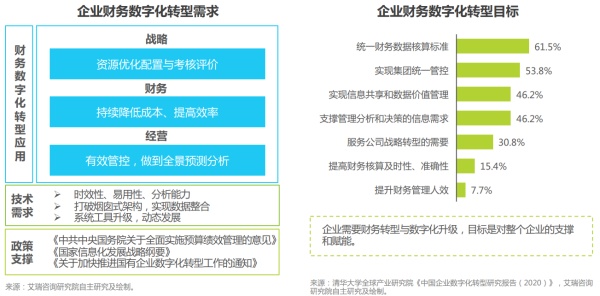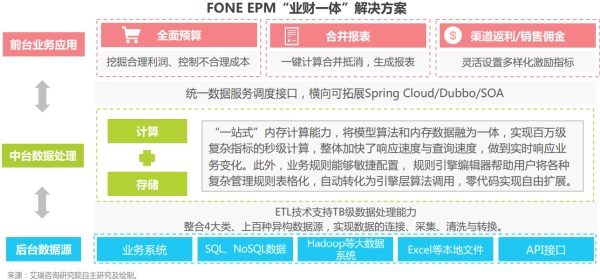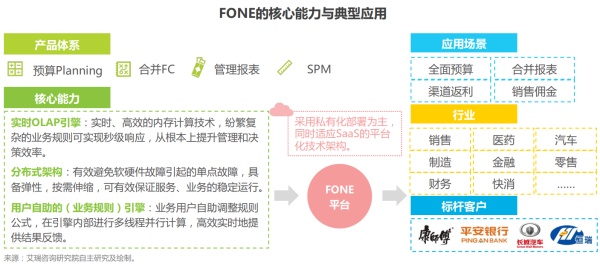The integration of EPM industry and finance is gaining momentum.

The integration of EPM industry and finance is gaining
momentum. How does FONE break through the boundaries of financial digitization?
The "2021 China EPM "Integration of Industry and
Finance" Industry Research Report" recently released by iResearch
also shows that the integration of EPM industry and finance will develop
towards a centralization and lightweight direction, with emphasis on cloud
native, data system construction, and large-scale development. Comprehensive
application of all-round technologies such as data, GPU, and AI.
Traditional financial services have long ceased to be the
goal of enterprises assiduously. The accountant who was hunched, bent over,
holding a water glass, and wearing reading glasses is no longer an image
endorsement of finance.
Nowadays, finance has been integrated into various business
activities of the enterprise and has become an important "dashboard"
for business managers to make business decisions. From the formulation of business
objectives, overall business planning, comprehensive budget planning, to
control during the execution process, prediction and analysis of operation and
financial indicators... With the advent of the EPM "integration of
business and finance" trend, the financial system has begun to continue to
evolve The new stage of digitalization has changed the previous state of
separation of business and financial systems, and integrated the two into a
comprehensive consideration. By strengthening the functions of the financial
department and providing forward-looking guidance for business development, the
two parties constitute a positive cycle of complementarity and complementarity.

The extension of enterprise services continues to expand,
and the integration of industry and finance has become an important direction
Looking back at the Chinese enterprise service market that
has emerged since 2013, IM, CRM, HR, expense control reimbursement, electronic
signature and other fields are the hot spots in the first half. The commonality
of these subdivisions is that they can help the relevant functional departments
of enterprises well. Optimize the work process to achieve more efficient
management.
From around 2018, with the further development of the mobile
Internet, the continuous growth of business data deposited by enterprises and
the improvement of data processing technology, enterprise customers have begun
to attach importance to the analysis capabilities of enterprise software
products. On the one hand, the main tracks of existing corporate services, such
as HR and CRM, are being transformed. For example, CRM product functions have
moved closer and closer to the core of customer relationship management from
the initial sales force management-analyzing past sales actions and strategies
To help make sales decisions.
On the other hand, new segmented products such as EPM
industry and financial integration are also emerging. Based on processes,
traditional financial systems such as bookkeeping, expense control, and reimbursement
have been relatively mature. They have helped customers realize basic digital
capabilities; and next, products that meet the needs of deeper business
analysis will become new opportunities. Among these deeper analysis and
decision-making needs, finance-related needs are obviously one of the core,
which also meets the needs of enterprises for financial digital transformation
to increasingly focus on the in-depth integration of finance and business.

It can be seen that finance has gradually transitioned from
a back-office business to a front-end business, from a feedback link to a
rehearsal link. The three most important things for an enterprise: capital
flow, information flow, and people flow, must be connected with finance, and
its role has changed from The support-oriented business has transformed into a
centralization and hub-based business. From this point of view, the market size
of the integration of industry and finance is larger than the market of pure
financial software in the past.
In the stock market, the depth and difficulty of enterprise
competition are intensifying. The market calls for a new generation of digital
tools that can improve the efficiency of enterprise operations. This trend is
breaking the boundaries between the original functional modules and levels of
the enterprise, and it is forcing the iteration of the enterprise software
ecosystem. And reorganization.
Since 2000, the integration of business and finance has been
mainly realized through the ERP system. However, the past ERP system emphasized
the use of one system to meet all needs from business to finance. This
large-scale approach puts too high requirements on the system, and the ultimate
outcome is often to reach a compromise and barely achieve business support.
Therefore, a mature EPM industry-finance integrated system
should be composed of the integration of business systems and financial
systems. But this has brought new problems, that is, the difficulty of system
integration has increased significantly. At the same time, the business system
has departed from the financial system's constraints, which has also led to a
substantial increase in the error rate of business data. The solution is to
build a central platform.
The integration of EPM industry and finance, which is
evolving toward centralization, will assume the functions of financial rule
provision, data processing, data storage and data analysis. Because it
verifies, converts and integrates data in all business systems, financial
accounting The system and business analysis system will obtain unified and
accurate data, speeding up the speed of financial accounting and analysis.
Because the business system is no longer subject to
financial rules and does not need to process financial data too much, it can obtain
maximum flexibility and quickly meet the needs of business changes. Such a
system modular design can not only realize cross-system sharing between master
data, business data, and application modules, but can also be combined with IT
systems through component plugging and unplugging to become a more efficient
landing form.
In addition, lightweighting is also one of the important
trends of EPM "integration of industry and finance" in the future.
The local deployment of traditional financial systems may only be updated every
few years, and customers need to pay for the new version; while the lightweight
model of SaaS cloud deployment can be updated in real time, and customers can
even use the latest version without perceiving it. The advantage of this service
increases customer stickiness.
The "2021 China EPM "Integration of Industry and
Finance" Industry Research Report" recently released by iResearch
also shows that the integration of EPM industry and finance will develop
towards a centralization and lightweight direction, with emphasis on cloud
native, data system construction, and large-scale development. Comprehensive
application of all-round technologies such as data, GPU, and AI.
Platform + product + scenario How can the integration of EPM
industry and finance be more valuable?
Behind the rapid development of EPM's integration of
industry and finance, the increasingly developed business digital environment
has put forward higher requirements for data processing capabilities. For those
enterprise customers with better IT foundations and certain system replacement
costs, they will also have to Choose a lighter and more flexible system to
adapt to the rapid iterative external market and frequent business adjustments.
The lighter posture has further helped EPM's integrated
products of industry and finance to open up a wider customer source space,
allowing the customer base to expand from large enterprises to small and
medium-sized enterprises. This is a much larger "sinking market" for
corporate services. After all, the number of large group companies is limited.
According to the National Bureau of Statistics, the number of large companies
in China currently does not exceed 50,000.
EPM industry-finance integrated vendors represented by FONE
are native in the big data era and cloud environment in terms of technical
architecture, so they can respond more quickly to customer business changes and
provide a new path for corporate financial digital management. FONE focuses on
core management requirements such as comprehensive enterprise budget
management, statement consolidation, sales performance management, management
statements, etc. It can help enterprises plan business, empower finance, help
enterprise strategy implementation, and achieve the "small goal" of
reducing costs and increasing efficiency.

Since the establishment of the company, FONE has continued
to invest a large amount of research and development resources in product
research and development, taking product research and development as the
internal driving force of the company's long-term development, and actively
building core technical barriers. Through self-developed M-OLAP (real-time
online computing engine), FONE breaks through the performance boundaries of
traditional EPM products and meets the needs of users for real-time calculation
and agile adjustment, so that users can get better support in later use and
expansion. Based on a reliable and efficient technology platform, FONE has now
built a matrix of EPM products including FONE Planning comprehensive budget
products, FONE FC consolidated statement products, FONE SPM commission cash
back and other products.

In terms of experience, FONE strives to provide customers
with a better application and service experience, mainly from the two aspects
of direct sales and channels for continuous improvement. Introduce a more
excellent business and consultant team in direct sales to provide users with a
rich product portfolio and business services.
In terms of delivery, FONE chose to cooperate with the four
major strategic consulting agencies, head integrators, and upstream and
downstream manufacturers to launch better overall solutions to meet the
different needs of users, continuously improve the quality of software
delivery, and provide users with high quality The maintenance services of the
company truly enable software products to provide users with value.
It can be seen from the development of FONE that every step
of FONE is always closely related to the development of EPM industry and finance.
With the development of the enterprise and market changes, it is also
conducting explorations that keep pace with the times. In view of the
enterprise's new requirements for business prediction, discovery and handling
of abnormal situations, how to deal with the situation, and the agile
adjustment ability of the system, FONE's products and services emphasize the
ease of use and high performance of the product, and users can self-configure,
At the same time, it meets the performance requirements of scenes such as rapid
prediction. In addition to the introduction of new technologies such as AI
algorithms, FONE is also more deeply integrated into the overall information
architecture of the enterprise. This can be seen from the Market Place
(business financial application market) launched by FONE this year.
In order to ensure that enterprises achieve the best
experience of integrating EPM, industry and finance, FONE pays full attention
to user experience from the user's perspective, penetrates the goal of
improving corporate efficiency into products and services, and presses the
"accelerator" for enterprise business innovation. Compared with the
basic digitalization of the financial system, the EPM industry-finance
integration system that can meet the needs of business analysis and
decision-making assistance of enterprises has the opportunity to obtain excess
dividends in the wave of big data. The biggest beneficiary.
If the enterprise is regarded as an ecosystem, after the
reform of the financial department, it will bring about changes in the
surrounding environment, which will bring about changes in systems, processes,
and data, which will affect the entire enterprise and improve the effectiveness
of all departments. . Just like the butterfly effect, the financial digital
transformation led by the integration of EPM industry and finance will not only
have a profound impact on the entire industry, but also create a broader new
world for enterprises.